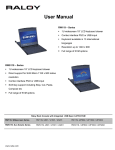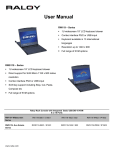Download RADAR LEVEL TRANSMITTER USER MANUAL
Transcript
RLT Instrumentation Pvt Ltd RADAR LEVEL TRANSMITTER USER MANUAL 1 People are our prime movers RLT Instrumentation Pvt Ltd TABLE OF CONTENTS INDEX PAGE NO 1. Safety Instructions 3 2. Identification 5 3. Installation 6 4. Wiring 17 5. Operation 22 6. Commissioning 48 7. Maintenance 52 8. Trouble- Shooting 52 9. Technical data 53 2 People are our prime movers RLT Instrumentation Pvt Ltd 1. Safety Instructions 1.1 Designated Use The Radar Level Transmitter for measuring level The manufacturer accepts no liability for damages resulting from incorrect use or use other than that designated 1.2 Installation, Commissioning and Operation The device has been designed to operate safely in accordance with current technical, safety Standards. If installed incorrectly or used for applications for which it is not intended, however, it is possible that application- related dangers may arise E.g. product due to incorrect installation or calibration. For this reason, the instrument must be installed, connected, operated and maintained according to the instructions in this manual: personnel must be authorized and suitable qualified. The manual must have been read and understood, and the instructions followed. Modifications and repairs to the device are permissible only when they are expressly approved in the manual. Pay particular attention to the technical data on the nameplate 1.3 Operational Safety 1.3.1 Hazardous areas (Optional) Devices for use in hazardous areas are fitted with an additional Nameplate. If the device is to be installed an explosion hazardous area, then the specifications in the certificate as well as al national and local regulations must be observed, a separate Ex documentation is enclosed with the device and is an integral part of this documentation. The installation regulations, connection values and safety instructions listed in this document must be observed. The documentation number of the related safety instructions is also indicated on the additional Nameplate. Ensure that all personnel are suitably qualified 3 People are our prime movers RLT Instrumentation Pvt Ltd 1.4 Notes on Safety Conventions and icons In order to highlight safety-relevant or alternative operating procedures in the manual, the following conventions have been used, each indicated by a corresponding icon in the margin Warning A warning highlights actions or procedures which, if not correctly, will lead to personal injury, a safety hazard or destruction of the instrument Caution! Caution highlights actions or procedures which, if not performed correctly, may lead to personal injury or incorrect functioning of the instrument Note! A note highlights actions or procedures which, if not performed correctly, may indirectly affect operation or may lead to an instrument response which is not planned. Device certified for use in explosion hazardous area If the device has this symbol embossed on its nameplate, it can be installed in an explosion hazardous area or a non-hazardous area, according to the approval. Explosion Hazardous area Symbol used in drawings to indicate explosion hazardous areas. - Devices used in hazardous areas must possess an appropriate type of protection Safe area (non-Explosion hazardous area) Symbol used in drawings to indicate, if necessary, non-Explosion hazardous areas 4 People are our prime movers RLT Instrumentation Pvt Ltd - Devices used in hazardous areas must possess an appropriate type of protection. Lines used in hazardous areas must meet the necessary safety-related characteristic quantities Direct Voltage A terminal to which or from which a direct current or voltage may be applied or supplied Alternating Voltage A terminal to which or from which an alternating (sine-Wave) current or voltage may be applied or supplied Grounded Terminal A Grounded terminal, which as far as the operator is connected, is already grounded by means of earth grounding Protective grounding (Earth) Terminal A terminal which must be connected to earth ground prior to making any other connection to the equipment Equipotential connection (Earth Bonding) A connection made to the plant grounding system which may be of type e.g. neutral star or Equipotential line according to national or company practice. 5 People are our prime movers RLT Instrumentation Pvt Ltd 3. INSTALLATION 3.1 Incoming acceptance and storage 3.1.1 Incoming acceptance Check the Packaging and the contents for damage Check the shipment, make sure nothing is missing and that the scope of supply matches your order 3.1.2 Storage The device must be stored in dry, clean area and protected against damage from impact 3.2 Installation Conditions 3.2.1 Dimensions For dimensions, please refer to the Technical information, mechanical construction section and Overview documentation 3.3 Installation Instructions Basic Requirements There is a certain existing beam angle while the antenna transmitting microwave pulses. There should be no barriers between the lower edge of antenna and surface of measured medium. Therefore it is highly recommended to avoid facilities inside vessels, such as ladders, limit switches, heating spirals, struts and etc, during the mounting process. “False echo learning” must be carried out during the installation in this case. Furthermore, microwave beams must NOT intersect the filling streams. Be cautions during the installation: the highest level of target medium must NOT enter into blanking zone; the instrument must keep certain distance to vessel walls; every possible measure needs to be taken to position the instrument so that the direction of antenna emission is perpendicular to the surface of measured medium. The installation of instruments in Explosion proof area must abide by relevant local or federal safety regulations. Aluminum housing should be used for intrinsically safe explosion proof version, which is also applicable in explosion proof areas. The instrument must be connected with ground in this case. 6 People are our prime movers RLT Instrumentation Pvt Ltd Illustrations Note: The highest level of measured medium must not enter into blanking zone while radar level measurement instrument is in operation. Mounting Position 7 People are our prime movers RLT Instrumentation Pvt Ltd 8 People are our prime movers RLT Instrumentation Pvt Ltd Damp Proof Antenna Extension 9 People are our prime movers RLT Instrumentation Pvt Ltd LTR56 Antenna Extension LTR57 Connecting Pipe Diagram 10 People are our prime movers RLT Instrumentation Pvt Ltd Rights and Wrongs in Mounting 11 People are our prime movers RLT Instrumentation Pvt Ltd Reflector Installation Agitator 12 People are our prime movers RLT Instrumentation Pvt Ltd Installation with Stand type By using standpipe, the influence of foams can be reduced. Note: You must NOT mount instrument inside stand pipe while measuring adhesive medium. Dimensional Details 6 Dimension (Unit: mm %) 13 People are our prime movers RLT Instrumentation Pvt Ltd 14 People are our prime movers RLT Instrumentation Pvt Ltd 15 People are our prime movers RLT Instrumentation Pvt Ltd 16 People are our prime movers RLT Instrumentation Pvt Ltd Parabolic antenna Wiring 4 ELECTRICAL CONNECTIONS Power Supply 20mA/HART (2-Wire) Power supply and current signal are carried by the same two-wire connection cable. See the Technical Specifications of this guide for detailed requirement on power supply. A safety barrier should be placed between power supply and instrument for intrinsically safe version. 20mA/HART (4-wire) Power supply and current signal are carried by two 2-wire connection cables respectively. See the Technical Specifications of this guide for detailed requirement on power supply. Earth-connected current output can be used for standard version of level instruments, while the explosion proof version must be operated with a floating current output. Both instruments and earth terminals should be connected with ground firmly and 17 People are our prime movers RLT Instrumentation Pvt Ltd securely. Normally you can either choose to connect with the earth terminal on vessel or adjacent ground in case of plastic vessels. Cable Connection General Introduction 4~20mA/HART Standard 2-wire cable with outside diameter of 5...9mm, which assures the seal effect of cable entry, can be used as feeder cable. You are recommended to use screened cables in the event of electromagnetic Connection cable with special earth wire can be used as feeder cable. Connection cable with special earth wire can be used as feeder cable. 20mA/HART (4-wire) Shielding & Grounding The two ends of shielded cable must be connected with earth terminal. The shielded cable must be connected with inner earth terminal directly inside the transducer, while the outside earth terminal on housing must be connected with ground. In the event of Earthconnected current, the shielding side of shielded cable must be connected to ground potential via a ceramic capacitor (e.g. : 1 F 1500V) in order to dampen the low frequency grounding current and avoid the disturbance caused by high frequency signals 2-wire Wiring Diagram 18 People are our prime movers RLT Instrumentation Pvt Ltd 2-wire wiring used for HART (electronic unit B) 1 Power Supply and Signal Output 4-wire/2-chamber Wiring Diagram: 220V AC Power Supply, 4…20mA Signal Output (electronic unit D) Wiring Diagram 4-wire 24V DC Power Supply, 4…20mA Signal Output (electronic unit C) 19 People are our prime movers RLT Instrumentation Pvt Ltd Wiring Diagram: dual-wire 24V DC Power Supply, 4…20mA Signal Output (electronic unit E) Explosion Proof Connection This product is an intrinsic safety explosion proof version (Exia II C T6) with aluminum housing and plastic encapsulated internal structure aimed to prevent sparks resulted from transducer and circuit malfunction from leaking out. It is applicable for the non-contact continuous level measurement of flammable medium under the level of explosion proof inferior to Exia II c T6.You are required to use FBS-2 series (intrinsic safety explosion proof: [Exia] II C voltage of power supply: 24V DC 5% short-circuit current: 135mA operating current: 4...20mA) of safety barriers, which are supplementary to this product, for the power supply of this product. 20 People are our prime movers RLT Instrumentation Pvt Ltd All connection cables must be screened with max. Length of 500m. Stray capacitor 0.1 F/Km, stray inductance 1mH/Km. The level measurement instrument must be connected to ground potential and unapproved supplementary devices are not allowed to use. Adjustment with SOFTWARE Adjust with Intrinsically Safe Flameproof Approval 21 People are our prime movers RLT Instrumentation Pvt Ltd SOFTWARE Connect with another unit through HART. 1. RS232 Connect Cable / USB port 2. LTR5X 3. HART port adapter used on COMWAY convertor 4. 250 ohm Resistance 5. COMWAY Convertor 6. Connect with another unit through I 2 C. 22 People are our prime movers RLT Instrumentation Pvt Ltd 1 RS232 Connect Cable/ USB port 2 LTR5X 3 I 2C adapter port used on MOMWAY convertor 4 COMWAY Convertor Operation 5 Adjustment Instructions Adjustment Methods Three adjustment methods available for LTR5X 1. Display / Adjustment Module 2. Adjustment software 3. HART handheld programmer View Point is a pluggable display/adjustment module. The adjustment can be done through operating with four buttons on View Point. Optional menu operation languages are available for selection. View Point is only used for display after adjustment in that the measurement results can be seen clearly through the glass window. Display/Adjustment Module 23 People are our prime movers RLT Instrumentation Pvt Ltd 1 LCD [ 2 Adjustment Keypad ] Keypad -Enter programming mode; -Confirm programming options; [B K]Keypad -Confirm modifications to parameters. -Modify parameter values. OK[ ] Keypad -Choose programming options; [ ] Keypad -Choose the digit of parameters to edit; -Programming mode exit; -Display the contents of parameters -Return to higher menu level. Shortcut [B K] Display Echo wave 24 People are our prime movers Program Instruction Adjustment parameter settings and testing’s can be done by the four keys View point Program Menu Structure Menu structure is shown in the appendix. Turn to next menu item Pointed by right arrow with OK. Turn to next menu item pointed by down arrow with Turn to left item with BK. Program Submenu Basic Settings Basic adjustment for the sensor is included in this menu. They are min. adjustment, max. Adjustment, medium, damping time, mapping curve, sealed units, scaling, near blanking and sensor tag. Display In this menu you can setup the sensor display mode and adjust B/W contrast for LCD Diagnostic In this menu you can store false echo curve and current output, Units of measurement, Language, rest HART operation mode, copy sensor data and PIN Info the information of sensor including sensor type, serial no, date of manufacturer, software version. Program Operation Enter program mode by press OK, Press OK after each parameter editing’s. Otherwise the modification will be abandoned. Press BK to quit program status. Parameter Editing Parameter Editing the first digit of the edited parameter will be displayed in black background on entering parameter editing. Modify the digit with . Then you can edit next digit with . After editing, press OK to confirm and store the modification Optional item Program some settings can be done by selecting one os several optional items with . And confirming with OK. Program Menu instruction 25 People are our prime movers Basic Settings Basic settings are basic setup of the sensor, such as min/ Max adjustment, medium, damping and etc. to bring the sensor to program mode from run mode, press OK. Then the menu is displayed as below ►Basic Settings Display Diagnostics Service Info Note: The menu item number is displayed on the top right corner 1.1 Min adjustment the item is one of the setting points that regulates the linear scaled current output. At main menu (the menu number is 1). Select basic settings with and confirm with OK, now the min. adjustment is displayed on LCD. The menu item number is 1.1 Min adjustment 1.1 0.00% 35.000 m (d) 1.346 m(d) Pressure OK, you can edit the percentage Value. Press OK again, you confirm the modification and further more you can edit the corresponding distance value. See parameter edition to learn how to edit parameters 1.2 Max. Adjustment The item is one of the two setting points that regulates the linear scaled current output. Pushing enter this menu when the menu item number is LCD displays 26 People are our prime movers Max adjustment 1.2 100.00% 0.000 m (d) 1.409 m(d) Pressure OK, you can edit the percentage value press OK again, you confirm the modification and further more you can edit the corresponding distance value. See parameter edition to learn how to edit parameters. 1.3 Medium Pushing enter this menu when the menu item number LCD displays as below each medium has different reflective properties. This menu is used to set the medium to be solid or liquid. Furthermore, make sure other relative factors Medium 1.3 Liquid ► Medium 1.3 ►Liquid Solid 27 People are our prime movers Move arrow with Solid or liquid can be selected. Pushing OK will confirm the selection and enter fast level change sub menu 1.3.1 Fast Level Change Pushing OK will enter this menu when it is liquid or solid selection menu and menu item number is LCD display as below Fast Level Change 1.3.1 Yes ► Push OK enter Fast Level change confirmation. LCD Displays as below Fast Level Change 1.3.1 Yes ►No Move arrow with with OK to select yes or No for Fast Level changes. Then confirm the selection 1.3.2 First Echo When medium is chosen as liquid or solid , LCD menu is press to displays as below Fast Echo Normal ► choose next menu. LCD 1.3.2 28 People are our prime movers Press OK to enter first echo menu LCD displays as below: Fast Echo 1.3.2 Normal Big Small Bigger Biggest Press---to choose the way to set first echo. There are five ways: Normal: No adjustments on first echo Small: decrease first echo by 10dB Big: Increase first echo by 10 dB Bigger: Increase first echo by 20 dB Biggest: Increase first echo by 40 dB 1.3.3 Liquid Agitated Surface When measure medium is liquid, LCD menu. Press OK to choose next menu and enter agitated surface. LCD displays as below: Agitated Surface 1.3.3 Or No► Agitated Surface Yes ►No Large Angle repose 1.3.3 1.3.3 No► Large Angle repose 1.3.3 Or Yes 29 ►No People are our prime movers Press OK to enter Agitated surface menu 1.3.3 (Solid) Large angler repose When measure medium is solid LCD menu. Press repose. LCD displays as below to choose next menu and enter angler Large Angle repose 1.3.3 Normal ► Press OK to enter large angler repose menu Large Angle repose 1.3.3 Yes ► No 1.3.4 (Liquid) Foaming Pushing will enter this menu when the menu item number is LCD displays as below Foaming No 1.3.4 ► 30 People are our prime movers Push OK, enter the submenu of foaming/powder dust confirmation. LCD displays as below 1.3.4 (Solid) Powder Dust Pushing will enter this menu when the menu item number is LCD displays as below Powder Dust No 1.3.4 ► Push OK, enter the submenu of foaming/powder dust confirmation. LCD displays as below Powder Dust 1.3.4 Yes ► No 1.3.5 Low DK Pushing will enter this menu when the menu item number is LCD displays as below Low DK 1.3.5 31 ► No People are our prime movers Push OK, enter the submenu of foaming/powder dust confirmation. LCD displays as below Low DK 1.3.5 Yes ► Move arrow with No to select yes or No for medium with Low DK. Then confirm with OK. 1.3.6. Measuring in Tube When measurement is carried through a tube, that is limited for the liquid medium, the tube diameter must be set in menu measure in tube so as to rectify the measuring error Pushing will enter this menu when the menu item number. LCD displays as below Measure in Tube ► 1.3.6 No Push OK, enter the submenu of measure in tube confirmation. LCD displays as below Measure in Tube ► 1.3.6 Yes No 32 People are our prime movers If the selection use is confirmed by OK, the diameter of the tube will be required. LCD displays as below Measure in Tube 1.3.6 Measure Diameter 0000mm Press OK, the value can be edited 1.3.1 Micro DK When choose micro OK as Medium property, press OK to enter micro DK setting Micro DK 1.3.1 Empty Span 10.00m True Lever 0.00m DK 1.00 0.020 m(d) Normally when electronic constant is smaller than 1.4, the direct echo from the medium is low and hard to detect. However by measuring the echo reflected from the base of the vessel, the height of the medium can be measured. Two parameters are needed to be entered here. 1. Height of empty vessel 2. True medium height or medium electronic constant, these two parameters are related, entering either one is accepted. The precision of parameters will affect the precision of the measurement 1.4 Damping Pushing will enter this menu when the menu item number 1.3. LCD displays as below Damping 1.4 OS 33 People are our prime movers Press OK, enter editing menu. See parameter edition to learn how to edit the parameter. To confirm the modification with OK, give up with BK 1.5 Mapping Curve This menu define the correlation between the measured value and the current output. Linear or non-linear mapping can be selected in this menu. For the non-linear correlations, parameters setting must be done by a computer previously. Pushing will select this menu when the menu item number is 1.4. LCD display as below Mapping Curve 1.5 Linear ► Press OK, enter editing menu. Move arrow with confirm with OK. to select linear or non-linear . Then 1.6 Scaled Units The unit of the scaled output value can be set in this menu. Pushing when item number is 1.5. LCD displays as below Scaled Units will enter this menu 1.6 Height ► M ► 34 People are our prime movers 1.7 Scaling Pushing OK to enter the editing menu, see parameter editing for the value editing, press OK to confirm the modification Scaling 1.7 0% 0.00m 100% 0.00m 1.8 Range Measure range should be set in order to get accurate result. When menu is 1.8, press enter Range. LCD displays as below Key to Press OK key to enter, Please see appendix as reference. When finishing editing parameter, Press OK key to confirm, or press BK to cancel Range 1.8 00.000 m(d) 1.9 Sensor Tag In the menu sensor TAG you edit a 11 digit measurement loop designation. The diameter set comprises: Letters from A-Z and Numbers from 0-9 Sensor Tag 1.9 SENSOR 35 People are our prime movers See Optional item programming to edit the tag name 2 . Display This menu is used to set display mode . Pushing item number is 1. LCD displays as below will select this menu when the main menu Basic Settings ► 2 Display Diagnostics Service Info Push OK, you get 2.1 Display Value Enter display mode set with OK. LCD displays as below Display Value 2.1 Distance ► Push OK, you can select different display types of the measured value as shown below Display Value ► 2.1 Shut off Map % Distance Scaled Height Current Percent 36 Percent People are our prime movers Move arrow to point to the type you want, confirm it with OK 2.2 LCD Contrast Adjustments Pushing will enter this menu when the menu item is 2.1. LCD displays as below LCD Contrast 2.2 Adjust? Adjust the B/W contrast by pressing OK, LCD displays as below LCD Contrast Increase contrast with 2.2 , decrease contrast with . confirm with OK. 3.Diagnostics The running status of the sensor can be provided by the menu diagnostics, and furthermore sensor testing can be done. Pushing below to select this menu when the main menu item number is 2. LCD displays as Basic Settings 3 Display ► Diagnostics Service 37 Info People are our prime movers Push OK, you get 3.1 Peak Values Peak values record the maximum and minimum distance. The records can be cleared to zero at menu 4.4 Peak Values 3.1 Distance-min 0.000m(d) Distance-max 2.109m(d) 3.2 Measurement status (measure) Pushing to display measuring status when the menu item is 3.1. LCD displays as below Meas Status 3.2 Meas reliability: 10dB Sensor Status: OK 3.3 Choose Curve (Echo Curve) At this menu, different curves can be selected to be displayed at menu 3, 4 when the menu item is 3.2 Presss . you get Choose Curve 38 3.3 Echo curve ► People are our prime movers Pushing OK to select the curve. There are three curves: Echo curve, false echo curve and output trend curve Choose Curve ► 3.3 Echo Curve False Echo Curve Output trend 3.4 Curve Pushing will display the selected curve when the menu item is 3.3. LCD displays as below Curve Zoom When the curve is displayed, pushing OK will enter curve Zoom function menu. Move arrow with , select menu item for X/Y axis Zoom. Then confirm with OK For X axis Zoom pushing to mark the start position for zoom, then confirm with OK. Pushing again to mark the end position for zoom and confirm with OK. The selected area of the curve will be shown on the whole screen. Exit zoom with BK. Echo Curve ► 3.4 X- Zoom Y-Zoom Unzoom 39 People are our prime movers 3.5 Simulation `Simulation is used to simulate the 4~20mA current output. By current output simulation the accuracy and linearity of the current output can be checked. And he system testing can be carried out. Push to enter simulation menu when the menu item number is 3.4 LCD displays as below Simulation 3.5 Start Simulation ► Pushing OK enter simulation mode selection menu: LCD Displays as below Pushing select the simulation mode. Then confirm with OK. The corresponding value will be required and then simulation starts Three types of simulations Percent: the output current is decided by a percent Value: 100% relative to 20mA 0% is relative to 4 mA Current: the Output current is regulated by a current value Distance: the output current is decided by a distance value. The current output depends on Min. adjustment (see 1.1), Max adjustment (see 1.2) and Mapping (see 1.5) 40 People are our prime movers 4.Service This menu with professional functions can only be used by trained technicians. They are false echo storage, reset, and sensor settings back up password setting and etc. Basic Settings 4 Display Diagnostics ► Service Info 4.1 False Echo High sockets or vessel installations. E.g. Struts or agitators as well as buildup and weld joints on the vessel walls cause interfering reflections which can impair the measurement. A false echo storage detects and marks these false echoes, so that they are no longer taken into account for the level measurement. A false echo memory should be created with empty vessel so that all potential interfering reflections will be detected Pushing OK will enter this menu when the menu item is 4 =. LCD displays as below False Echo 4.1 Change? Then Push OK, LCD displays as below False Echo ► 4.1 Delete Update Create New 41 Edit People are our prime movers With select Update/ Create new/ Delete a false echo, confirm with OK False Echo 4.1 Update/ create new 01.000 m(d) When you select update create/new, you are asked to input a distance value for the real echo. Then push OK to confirm it and to start the operation. It will take some time to store the false echo. Note: Check the distance to the product surface. Because if an incorrect (too large) value is entered, the existing level will be saved as false signal. The filling level would then no longer be detectable in this area To edit a false echo curve, press the button, move the arrow to the desired section will be present, Press OK key to confirm. This feature has been built on false echo to edit or change to meet the special requirements of working conditions, access to virtual. False echoes editing interface is as follows: (Note: this menu requires professionals to operate ) False Echo Edit 4.1 Start 1.00 amplitude 1300 Stop 2.00 amplitude 1200 M(d) 42 People are our prime movers Each curve edit points, start point and end point coordinates for the curve you want to edit, then the corresponding range of values. Is to modify the value (Note: When the distance coordinate input or modified, then the rate will automatically be the root corresponding according to the current saved data update rate changes used as a reference); Two pairs of coordinates after editing press OK to confirm the amendment; instrument will automatically enter the two points into the line with mew false echo generated curve, to replace the original curve; press OK to confirm , the interface will show the received by this false echo curve for reference, then edited by BK to return to the above interface to edit, when the editor has been confirmed false echo conditions required to be false then echo BK exit the Edit menu, then the interface displays the following: Press OK button to save the above changes, according to BK key to abandon the current changes 4.2 Current Menu Current Output ► 4.2 Output Mode Failure mode Min Current 43 People are our prime movers Output mode Select output as 4-20 mA or 20-4 mA means the min. levels is corresponding to 4mA and the Max. Level is corresponding to 20 mA. 20-4 mA mean the min. level is corresponding to 20 mA and the Max. Level is corresponding to 4mA. When the arrow points at output mode, push OK you get Output mode ► 4.2 4~20 mA 20-4 mA Push , you select the item you want and confirm with . Failure Mode Setup the output current on sensor error. Three status are available. When the arrow points at output mode, push you get item failure mode and confirm with OK. Current Output ► 4.2 No Change 20.5 mA 22.0 mA Min Current Setup the minimal output current is 4mA or 3.8 mA. When the arrow points at fail mode, push You get min. current menu. Confirm with OK. You get Min Current ► 4.2 3.9 mA 4 mA 44 People are our prime movers Select the item you want with and confirm with OK. 4.3 Reset With the reset function, modified settings are reset. Three sub functions are available: Basic Settings - Reset settings modified with view point to the default values factory settings Reset special settings as well as basic settings to default values peak measured values Reset the min/ Max level records When the menu item is 4.2, Push , you get Reset 4.3 Select Reset ► Push OK, LCD displays as below Reset 4.3 Basic Adjustment Factory settings Peak values menu Select the item with confirm with OK, 4.4 Units of Measure Two sets of measure system units are available. The metric system and the British system Units of Measurement 4.4 m(d)45► People are our prime movers Push OK, to edit it 4.5 Language Language 4.5 English ► Push OK, to edit it 4.6 HART Operation Mode HART offers standard and multidrop mode. The standard mode with the fixed address 0 means output of the measured value as 4…20 mA signal. In multidrop mode, up to 15 sensors can be operated on one two-wire cable In this menu you determine the HART mode and enter the address for multidrop HART Operation mode 4.6 Standard Address 0 Push OK, you can select HART operation mode HART Operation mode ► 4.6 Standard Multidrop 46 People are our prime movers The default setting is standard mode with address 0. 4.7 Copy Sensor Data In this menu you back up the sensor settings so as to restore them when necessary Copy Sensor mode 4.7 Copy Sensor date? Push OK, LCD displays below Copy Sensor date ► 4.7 Copy from sensor Copy to Sensor Copy from sensor means to save the sensor settings and copy to sensor means to restore the sensor settings 4.8 PIN In this menu, the PIN is activated/ inactivated permanently. Entering a 4-digit PIN protects the sensor data against unauthorized access and unintentional modifications PIN 4.8 Enable? PIN 47 4.8 Cancel? People are our prime movers 4.9 Distance Adjustment Distance Adj. is used to correct the difference between the measured value and actual distance. When menu is 4.8, press to enter distance Adj. LCD displays as below: press OK to enter setting Distance Adj 4.8 +0.000 m(d) 4.10. Threshold Setting (Note: This menu requires professionals to operate) Threshold set used to set the effective size of the echo threshold, threshold set higher, ask to respond effectively to fluctuations in degree, that greater benefit exclude the small signal clutter; but definitely Note: if you modify the threshold value is greater than the effective Echo amplitude, the wave will cause the result of misunderstanding, the menu includes echo threshold and amplitude envelope, which the default rate of return threshold for the 60mV, amplitude envelope default value of 10mV Threshold 4.10 Echo threshold 60 Envelope level 10 5. Info In this menu the most important sensor information can be displayed, 48 People are our prime movers Sensor type: E.g. LTR Serial No: E.g 123456 Date of manufacturer: E.g 2013-01-01 Software Version: E.g. 06.08.28 Pushing below will select this menu when the main menu item number is 4. LCD displays as Basic Settings 5 Display Diagnostics Service ► Info Then Pushing OK enters the info display menu. LCD displays as below Sensor Type 5.1 LTR series Serial No 123456 Pushing LCD Displays as below Date of Manufacturer 5.2 2006-01-01 Software Version 13.03.2013 49 People are our prime movers Example: To Display echo curve do as follow: 1. Push OK to enter Program status. Main menu is displayed on LCD 2. Push twice to select diagnostics submenu item 3. Push OK to enter the submenu number 3.1 4. Push to enter next menu, the menu number is 3.2 5. Push again, the menu number is 3.3 6. Push OK to enter the curve select menu (3.3) 7. Set arrow to point to echo curve with 8. Push OK to confirm 9. Push the echo curve will be shown. Menu number is 3.4 10. Push OK to enter curve zoom menu 11. Push to select X-Zoom 12. Push OK to Confirm Push to mark the start position 13. Push OK to confirm 14. Push to mark the end position 15. Push OK to confirm. The area of the curve you select will be shown on the whole screen 16. Push BK several times to return to run state Note: Shortcut Key BK can display echo curve on measurement mode, but it has no zoom functions. Commissioning 2-Wire Load Resistance Diagram Characteristic Blanking Distance End of Antenna 50 People are our prime movers Parameter Max. Measuring Distance LTR55 10M (liquid) LTR56 30M (liquid) LTR57 20M (liquid) LTR58 70M (solid) LTR59 15M (solid) Microwave Frequency 26GHz Measurement Interval About 1sec Depend on parameter settings Adjustment Time1) About 1sec Depend on parameter settings Resolution of Display 1mm Accuracy See the diagram below Temperature for Storage/Transport (-40~100) ºC Process Temperature (Probe) LTR55 (-40~130) degC LTR56 (-60~400) degC LTR57 (-40~150) degC LTR58 (-60~400) degC LTR59 (-40~200) degC Relative Humidity <95% Pressure Max 40MPa Vibration Proof Mechanical vibration10m/s 10m /s; 10~ 150Hz LTR 51 People are our prime movers The generation of accurate measurement results needs longer time than usual in the event of drastic level changes (mx. Error 10%). LTR56 3dB Beam Angle -φ48mm 18º -φ75mm 12º -φ98mm 8º -φ123mm 6º Accuracy See the accuracy illustration diagram below LTR57 3dB Beam Angle 52 People are our prime movers flangeDN50 18º flangeDN80 12º Accuracy See the accuracy illustration diagram below LTR58 3dB Beam Angle -φ48mm 18º -φ75mm 12º -φ98mm 8º -φ123mm 6º -φ196mm 5º -φ246mm 4º Accuracy See the accuracy illustration diagram below 53 People are our prime movers LTR59 3dB Beam Angle φ48mm 18º φ75mm 12º φ98mm 8º φ123mm 6º φ196mm 5º φ246mm 4º Accuracy See the accuracy illustration diagram below Maintenance Exterior Cleaning Please note the following points when cleaning the device The Cleaning agents used should not attach the surface and the seals Mechanical damage to the membrane, e.g. due to pointed objects, must be avoided Observe degree of protection. See therefore nameplate if necessary 54 People are our prime movers Trouble Shooting LCD Display Information ROM verification Error Logger reading error Causes *ROM operation illegal/ Error *Stored parameters are wrong System Logger error *System stored data area has error *Sub-CPU circuit errors Measuring circuit hardware error Date time error *System timer has errors No Display. Erratic or abnormal Operation *Problem with wiring No Response to key pressing *Keypad is locked *Bad Plug connection Solution * contact the manufacturer *Power On again/ contact the manufacturer *Power On again/ contact the manufacturer *Power On again/ contact the manufacturer *Power On again/ contact the manufacturer *Check wiring connections. No influence of measuring normally * Input password to unlock keyboard or check wiring connections, no influence of measuring normally Technical Data LTR51 Explosion Proof Approval P- Standard (Without Approval) I- Intrinsically Safe (Ex ia IIB T6) C- Intrinsically safe+ Ship Approval (Exia IIC T6) (No) 55 People are our prime movers G- Intrinsically Safe+ Flame Proof Approval (Exd ia IIC T6) Shape of Antenna/ Material/ Process Temperature A- Plastic Rod/ PP/ -40~120° C B- Plastic Rod/ PTFE/ -40~120°C Length of Vessel Socket A 50mm B 100mm C 150mm D 200mm E 250mm F 300mm X Special Version Process Connection/ Material GP Thread G1 ½ A NP Thread 1 ½ NPT YP Special Design Electronic B- (4-20)mA/HART 2-wire C- (4-20)mA/(22.8~26.4) V DC/ HART 2-wire/ 4-wire D- (198-242)V AC/HART 4-wire E- (4-20) mA/ (22.8~26.4) V DC/ HART 2-wire (2-Chamber) X- Special Version Housing/ Protection A-Aluminium/IP67 B-Plastic/ IP66 D-Aluminium (2-Chamber)/ IP67 G-Stainless Steel316L/ IP67 H-Stainless Steel316L (2-Chamber)/ IP67 Cable Entry M- M20×1.5 N- ½ NPT Display / Programming A- Yes X- No Note: the instrument with approval “I” can only use electronic “B” and housing “A”. The instrument with approval “C” can only use electronic “B” and housing “G”. the instrument with approval “G” can only use electronic “C” or “D”, E and housing “D” Standard flange size of the reference GB/T9119-2000 Thickness of 15 LTR52 Explosion Proof Approval 56 People are our prime movers P- Standard (Without Approval) I- Intrinsically Safe (Ex ia IIB T6) C- Intrinsically safe+ Ship Approval (Exia IIC T6) (No) G- Intrinsically Safe+ Flame Proof Approval (Exd ia IIC T6) Shape of Antenna/ Material/ Process Temperature B- Plastic Rod/PTFE/ -40~150°C Length of Vessel Socket A 50mm B 100mm C 150mm D 200mm E 250mm F 300mm X Special Version Process Connection/ Material FC PTFE Loose Flange with Stud end DN50 PN1.6 SS316L (GB/T9119-2000) FD PTFE Loose Flange with Stud end DN80 PN1.6 SS316L (GB/T9119-2000) FE PTFE Loose Flange with Stud end DN100 PN1.6 SS316L (GB/T9119-2000) FC PTFE Loose Flange with Stud end DN150 PN1.6 SS316L (GB/T9119-2000) YP Special Design Electronic B- (4-20)mA/HART 2-wire C- (4-20)mA/(22.8~26.4) V DC/ HART 2-wire/ 4-wire D- (198-242)V AC/HART 4-wire E- (4-20) mA/ (22.8~26.4) V DC/ HART 2-wire (2-Chamber) X- Special Version Housing/ Protection A-Aluminium/IP67 B-Plastic/ IP66 D-Aluminium (2-Chamber)/ IP67 G-Stainless Steel316L/ IP67 H-Stainless Steel316L (2-Chamber)/ IP67 Cable Entry M- M20×1.5 N- ½ NPT Display / Programming B- Yes X- No Note: the instrument with approval “I” can only use electronic “B” and housing “A”. The instrument with approval “C” can only use electronic “B” and housing “G”. the instrument with approval “G” can only use electronic “C” or “D”, E and housing “D” Standard flange size of the reference GB/T9119-2000 Thickness of 15 57 People are our prime movers LTR 53 Explosion Proof Approval P- Explosion Proof Approval I- Intrinsically Safe (Ex ia IIC T6) C- Intrinsically safe+ Ship Approval (Exia IIC T6) (No) G- Intrinsically Safe+ Flame Proof Approval (Exd ia IIC T6) Shape of Antenna/ Material C- Horn φ50mm/SS316L (Only applicable for installation with Standpipe)* D- Horn φ80mm/SS316L (Only applicable for installation with Standpipe)* E- Horn φ100mm/SS316L F- Horn φ150mm/SS316L G- Horn φ200mm/SS316L K- Horn φ100mm/SS316L/ Internal PTFE Coating L- Horn φ150mm/SS316L/ Internal PTFE Coating Antenna A No B 200mm C 500mm D 1000mm E 2000mm X Special Version Process Connection/ Material FA Flange DN50 PN1.6 SS316L(GB/T9119-2000) FB Flange DN80 PN1.6 SS316L(GB/T9119-2000) FC Flange DN100 PN1.6 SS316L(GB/T9119-2000) FD Flange DN150 PN1.6 SS316L(GB/T9119-2000) FE Flange DN200 PN1.6 SS316L(GB/T9119-2000) YP Special Design Seal/ Process Temperature 2- Viton/ -40~130°C 3- Kalrez/ -20~130°C 4- Viton/ -40~200°C with radiator fins (Process Temperature > 100°C) 5- Viton/ -20~200°C with radiator fins (Process Temperature > 100°C) Electronic B- (4-20)mA/HART 2-wire C- (4-20)mA/(22.8~26.4) V DC/ HART 2-wire/ 4-wire D- (198-242)V AC/HART 4-wire E- (4-20) mA/ (22.8~26.4) V DC/ HART 2-wire (2-Chamber) X- Special Version Housing/ Protection A-Aluminium/IP67 B-Plastic/ IP66 58 People are our prime movers D-Aluminium (2-Chamber)/ IP67 G-Stainless Steel316L/ IP67 H-Stainless Steel316L (2-Chamber)/ IP67 Cable Entry M- M20×1.5 N- ½ NPT Display / Programming A- Yes X- No Huff A- Yes X- No Note: the instrument with approval “I” can only use electronic “B” and housing “A, D, G, H”. The instrument with approval “C” can only use electronic “B” and housing “G”. the instrument with approval “G” can only use electronic “C” or “D”, E and housing “D” Standard flange size of the reference GB/T9119-2000 Thickness of 15mm LTR54 Explosion Proof Approval P- Explosion Proof Approval I- Intrinsically Safe (Ex ia IIC T6) C- Intrinsically safe+ Ship Approval (Exia IIC T6) (No) G- Intrinsically Safe+ Flame Proof Approval (Exd ia IIC T6) Shape of Antenna/ Material F- Horn φ150mm/SS316L G- Horn φ200mm/SS316L H- Horn φ200mm/SS316L Antenna A No B 200mm C 500mm D 1000mm X Special Version Process Connection/ Material FB Flange DN150 PN1.6 SS316L(GB/T9119-2000) FC Flange DN200 PN1.6 SS316L(GB/T9119-2000) YP Special Design Seal/ Process Temperature 2- Viton/ -40~130°C 3- Kalrez/ -20~130°C 4- Viton/ -40~200°C with radiator fins (Process Temperature > 100°C) 59 People are our prime movers 5- Viton/ -20~200°C with radiator fins (Process Temperature > 100°C) Electronic B- (4-20)mA/HART 2-wire C- (4-20)mA/(22.8~26.4) V DC/ HART 2-wire/ 4-wire D- (198-242)V AC/HART 4-wire E- (4-20) mA/ (22.8~26.4) V DC/ HART 2-wire (2-Chamber) X- Special Version Housing/ Protection A-Aluminium/IP67 B-Plastic/ IP66 D-Aluminium (2-Chamber)/ IP67 G-Stainless Steel316L/ IP67 H-Stainless Steel316L (2-Chamber)/ IP67 Cable Entry M- M20×1.5 N- ½ NPT Display / Programming B- Yes X- No Huff B- Yes X- No Note: the instrument with approval “I” can only use electronic “B” and housing “A, D, G, H”. The instrument with approval “C” can only use electronic “B” and housing “G”. the instrument with approval “G” can only use electronic “C” or “D”, E and housing “D” Standard flange size of the reference GB/T9119-2000 Thickness of 15mm LTR55 Explosion Proof Approval P- Explosion Proof Approval I- Intrinsically Safe (Ex ia IIC T6) C- Intrinsically safe+ Ship Approval (Exia IIC T6) (No) G- Intrinsically Safe+ Flame Proof Approval (Exd ia IIC T6) Shape of Antenna/ Material/ Process Temperature B- (R) Airproof Horn 50/ PTFE/ (-40~130) °C C- (R) Airproof Horn 80/ PTFE/ (-40~130) °C Process Connection/ Material GP (F) Thread G1 ½ A NP (F) Thread 1 ½ NPT FA (L) Flange DN50/ PTFE FB (L) Flange DN50/ PTFE 60 People are our prime movers FX Special Design Length of vessel Socket A 100mm B 200mm Electronic B- (4-20)mA/HART 2-wire C- (4-20)mA/(22.8~26.4) V DC/ HART 2-wire/ 4-wire D- (198-242)V AC/HART 4-wire E- (4-20) mA/ (22.8~26.4) V DC/ HART 2-wire (2-Chamber) X- Special Version Housing/ Protection A-Aluminium/IP67 B-Plastic/ IP66 D-Aluminium (2-Chamber)/ IP67 G-Stainless Steel316L/ IP67 H-Stainless Steel316L (2-Chamber)/ IP67 Cable Entry M- M20×1.5 N- ½ NPT Display / Programming C- Yes X- No Note: the instrument with approval “I” can only use electronic “B” and housing “A, D, G, H”. The instrument with approval “G” can only use electronic “C or D, E” and housing “ D, H” Standard flange size of the reference GB/T9119-2000 Thickness of 15mm LTR56 Explosion Proof Approval P- Explosion Proof Approval I- Intrinsically Safe (Ex ia IIC T6) C- Intrinsically safe+ Ship Approval (Exia IIC T6) (No) G- Intrinsically Safe+ Flame Proof Approval (Exd ia IIC T6) Shape of Antenna/ Material B- (T) Horn φ48mm/ SS316L C- (T) Horn φ78mm/ SS316L H- (T) Horn φ98mm/ SS316L I- (T) Horn φ98mm (Lengthen)/ SS316L 61 People are our prime movers J- (T) Horn φ123mm/ SS316L K- (S) Horn φ98mm/ PP/ PTFE Shield (No) L- (S) Horn φ98mm (Lengthen)/ PP/ PTFE Shield (No) M- (V) Horn φ98mm / SS316L/ PTFE Shield (No) N- (V) Horn φ98mm (lengthen) / SS316L/ PTFE Shield P- (V) Horn φ123mm / SS316L/ PTFE Shield X- Special Version Process Connection/ Material GP (H) Thread G 1 ½ A/ SS316L GA (H) Thread 1 ½ NPT/ SS316L GB (G) Thread G 1 ½ A/ PP GC (J) Thread G 1 ½ A/ SS316L/ Temperature (-60~250)°C GD (K) Thread G 1 ½ A/ SS316L/ Temperature (-60~400)°C, Pressure 40 Mpa GE (I) Thread G 1 ½ A/ SS316L (Huff) GX Special Design Flange Material F0 No FX Special Version Seal/ Process Temperature 2- Viton/ -60~200°C 3- Kalrez/ -60~250°C 4- Graphite -60~400°C Electronic B- (4-20)mA/HART 2-wire C- (4-20)mA/(22.8~26.4) V DC/ HART 2-wire/ 4-wire D- (198-242)V AC/HART 4-wire E- (4-20) mA/ (22.8~26.4) V DC/ HART 2-wire (2-Chamber) X- Special Version Housing/ Protection A-Aluminium/IP67 B-Plastic/ IP66 D-Aluminium (2-Chamber)/ IP67 G-Stainless Steel316L/ IP67 H-Stainless Steel316L (2-Chamber)/ IP67 Cable Entry M- M20×1.5 N- ½ NPT Display / Programming D- Yes X- No 62 People are our prime movers Note: the instrument with approval “I” can only use electronic “B” and housing “A, D, G, H”. The instrument with approval “C” can use electronic “B” and housing “G” The Instrument with approval “G” can use electronic “C or D, E” and housing “D, H” Standard flange size of the reference GB/T9119-2000 Thickness of 15mm LTR57 Explosion Proof Approval P- Explosion Proof Approval I- Intrinsically Safe (Ex ia IIC T6) C- Intrinsically safe+ Ship Approval (Exia IIC T6) (No) G- Intrinsically Safe+ Flame Proof Approval (Exd ia IIC T6) Shape of Antenna/ Material B- (U) Stainless Steel & PTFE Flange DN50 C- (U) Stainless Steel & PTFE Flange DN80 D- (U) Stainless Steel & PTFE Flange DN100 X- Special Version Electronic B- (4-20)mA/HART 2-wire C- (4-20)mA/(22.8~26.4) V DC/ HART 2-wire/ 4-wire D- (198-242)V AC/HART 4-wire E- (4-20) mA/ (22.8~26.4) V DC/ HART 2-wire (2-Chamber) X- Special Version Housing/ Protection A-Aluminum/IP67 B-Plastic/ IP66 D-Aluminum (2-Chamber)/ IP67 G-Stainless Steel316L/ IP67 H-Stainless Steel316L (2-Chamber)/ IP67 Cable Entry M- M20×1.5 N- ½ NPT Display / Programming A- Yes 63 People are our prime movers X- No Note: The Instrument with approval “I” can be use Electronic “B” and housing “A, D, G, H” The instrument with “G” can use electronic “C or D, E and housing “D, H” Standard flange size of the reference GB/119-2000 thickness of 15mm LTR 58 Explosion Proof Approval P- Explosion Proof Approval I- Intrinsically Safe (Ex ia IIC T6) C- Intrinsically safe+ Ship Approval (Exia IIC T6) (No) G- Intrinsically Safe+ Flame Proof Approval (Exd ia IIC T6) Shape of Antenna/ Material B- (T) Horn φ48mm/ SS316L C- (T) Horn φ78mm/ SS316L H- (T) Horn φ98mm/ SS316L I- (T) Horn φ98mm (Lengthen)/ SS316L J- (T) Horn φ123mm/ SS316L K- (S) Horn φ98mm/ PP/ PTFE Shield (No) L- (S) Horn φ98mm (Lengthen)/ PP/ PTFE Shield (No) M- (V) Horn φ98mm / SS316L/ PTFE Shield (No) N- (V) Horn φ98mm (lengthen) / SS316L/ PTFE Shield P- (V) Horn φ123mm / SS316L/ PTFE Shield Q- (W) Parabolic φ196mm/ SS316L R- (W) Parabolic φ246mm/ SS316L X- Special Version Process Connection/ Material GP (H) Thread G 1 ½ A/ SS316L GA (H) Thread 1 ½ NPT/ SS316L GB (G) Thread G 1 ½ A/ PP 64 People are our prime movers GC (J) Thread G 1 ½ A/ SS316L/ Temperature (-60~250)°C GD (K) Thread G 1 ½ A/ SS316L/ Temperature (-60~400)°C, Pressure 40 Mpa GE (I) Thread G 1 ½ A/ SS316L (Huff) GF (E) Thread G 1 ½ A/ SS316L/ Temperature (-60~150)°C GG (E1) Thread G 1 ½ A/ SS316L/ Temperature (-60~250)°C GX Special Design Flange Material F0 No FX Special Version Seal/ Process Temperature 2- Viton/ -60~200°C 3- Kalrez/ -60~250°C 4- Graphite -60~400°C Electronic B- (4-20)mA/HART 2-wire C- (4-20)mA/(22.8~26.4) V DC/ HART 2-wire/ 4-wire D- (198-242)V AC/HART 4-wire E- (4-20) mA/ (22.8~26.4) V DC/ HART 2-wire (2-Chamber) X- Special Version Housing/ Protection A-Aluminium/IP67 B-Plastic/ IP66 D-Aluminium (2-Chamber)/ IP67 G-Stainless Steel316L/ IP67 H-Stainless Steel316L (2-Chamber)/ IP67 Cable Entry M- M20×1.5 N- ½ NPT Display / Programming A- Yes X- No Note: The Instrument with approval “I” can use electronic “B” and housing “ A, D, G, H” The instrument with approval “G” can use electronic “C or D, E” and housing “D, H” Standard flange size of the reference GB/T9119- 2000 Thickness of 15mm 65 People are our prime movers LTR59 Explosion Proof Approval P- Explosion Proof Approval I- Intrinsically Safe (Ex ia IIC T6) C- Intrinsically safe+ Ship Approval (Exia IIC T6) (No) G- Intrinsically Safe+ Flame Proof Approval (Exd ia IIC T6) Shape of Antenna/ Material B- (T) Horn φ48mm/ SS316L C- (T) Horn φ78mm/ SS316L H- (T) Horn φ98mm/ SS316L I- (T) Horn φ98mm (Lengthen)/ SS316L J- (T) Horn φ123mm/ SS316L K- (S) Horn φ98mm/ PP/ PTFE Shield (No) L- (S) Horn φ98mm (Lengthen)/ PP/ PTFE Shield (No) M- (V) Horn φ98mm / SS316L/ PTFE Shield (No) N- (V) Horn φ98mm (lengthen) / SS316L/ PTFE Shield P- (V) Horn φ123mm / SS316L/ PTFE Shield Q- (W) Parabolic φ196mm/ SS316L R- (W) Parabolic φ246mm/ SS316L X- Special Version Process Connection/ Material GP (H) Thread G 1 ½ A/ SS316L GA (H) Thread 1 ½ NPT/ SS316L GB (G) Thread G 1 ½ A/ PP GC (J) Thread G 1 ½ A/ SS316L/ Temperature (-60~250)°C GE (I) Thread G 1 ½ A/ SS316L (Huff) GF (E) Thread G 1 ½ A/ SS316L/ Temperature (-60~150)°C GG (E1) Thread G 1 ½ A/ SS316L/ Temperature (-60~250)°C GX Special Design Flange Material F0 No FX Special Version Electronic B- (4-20)mA/HART 2-wire C- (4-20)mA/(22.8~26.4) V DC/ HART 2-wire/ 4-wire D- (198-242)V AC/HART 4-wire E- (4-20) mA/ (22.8~26.4) V DC/ HART 2-wire (2-Chamber) X- Special Version Housing/ Protection A-Aluminium/IP67 B-Plastic/ IP66 D-Aluminium (2-Chamber)/ IP67 66 People are our prime movers G-Stainless Steel316L/ IP67 H-Stainless Steel316L (2-Chamber)/ IP67 Cable Entry M- M20×1.5 N- ½ NPT Display / Programming A- Yes X- No Note: The instrument with approval “I” can use electronic “B” and housing “A, D, G, H” The instrument with approval “G” can use electronic “C or D, E and housing “D, H”, Standard flange size of the reference GB/ T9119-2000 thickness 15mm 67 People are our prime movers Basic Settings: 68 People are our prime movers Basic Settings: Basic Settings 1 Echo Curve 4.1 Delete, Update, Create new, Edit Display 2 Current Output 4.2 Output mode failure mode min mode Diagnostics Reset 4.3 Select reset Sensor 4 Units of Measurement 4.4 M (d) ft (d) Info5 Language 4.5 English HART Operation mode 4.6 Standard Multidrop Copy Sensor Data 4.7 Copy from sensor copy to sensor Basic reset Factory settings Peak values PIN 4.8 Distance Adj 4.9 Threshold 4.10 Date of Manufacturer software Version 5.2 Sensor Type 5.1 69 People are our prime movers Head Office RLT INSTRUMENTATION PVT.LTD, #2, Rangarajapuram 1st Street, Kodambakam, Chennai – 600024. Ph: 044-24806500 (10 Lines); Fax: 044-24806555 E-mail: [email protected] ; Website: www.rltech.in 70 People are our prime movers






































































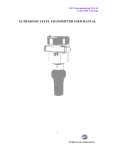
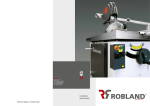
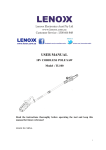
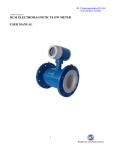

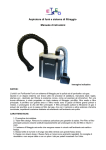

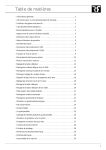
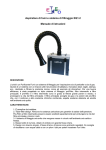
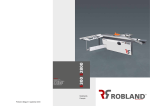


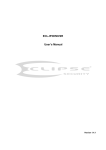
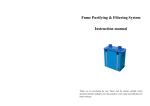

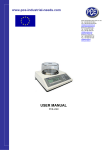
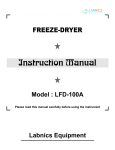

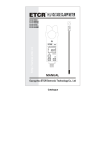
![EA986D-13(油圧リフティングローラー[2台組])取扱説明書](http://vs1.manualzilla.com/store/data/006680079_2-bab891667259b91192624446722db395-150x150.png)
